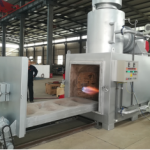Items/Model
TS50(PLC)
Picture

Principle
Medical Waste Incineration
Burn Rate
50-100 kg/hour
Control Mode
PLC(Programmable Logic Controller Incinerator)
Combustion Chamber
560L
Internal Dimensions
100x80x70cm
Secondary Chamber
280L
Smoke Filter Chamber
Gas Flue Washing System incineration of medical waste
Feed Mode
Manual
Voltage
220V
Power
4.0 Kw
Oil Infection (kg/hour)
Typical 16.9
Gas Consumption (m3/hour)
Typical 20.2
Infection Monitor
Digital Display
Temperature Protection
Yes
Oil Tank
100L
Feed Door
70x55cm
Chimney
15Meter
Chimney Sort
S.Steel
1st.
1000℃-1200℃
Residency Time
2.0 Sec.
Three Combustion Chambers(Optional)
3 Chambers for high risk waste
Pet Cremation Equipment
For Pet(small/big) Cremation Business
Animal Incineration Equipment
For additional creature incineration
Email: [email protected]
|
|
ü BIO-Medical/Hospital Waste Incinerator Modular Package Form, free standing unit consisting of (Primary chamber, Secondary Chamber, stake, controller and gas flue washing machine ) how can a waste to energy plant work |
|
ü Diesel Oil And GAS Fired Burners (Dual) |
ü Stainless Steel stack for strength |
|
ü Burning capability: 50-60kgs of waste ruined per hour. |
ü Average ash residue: 3 to 4 percent |
|
ü Operating Temperature 850°C to maximum 1320°C or better: |
ü Upto 1150°C in a secondary chamber |
|
ü Residency Time in Secondary Chamber of two minutes |
ü Thick refractory liner & insulation more than 200mm rated to 1600°C in primary chamber retains warmth, increasing efficacy |
|
ü Separate doors for loading and ash removal |
ü Loading door for maximum operator protection for immediate heat exposure |
ü Burner with temperature activated modulating control
ü Dual HT Thermocouples: Allow independent control of Primary and secondary temperatures through the control panel
ü Stress mill with modulating air controller
ü Stainless Steel cladding for optimum heat retention, cool touch and hygiene controller
ü Rapid, efficient and complete medical waste disposal
ü Safe use manage
ü high-quality liner and insulatio,management of hazardous waste
ü PLC touch screen, double burner controller, preset burn times and blower
ü Temperature monitoring
ü Programmable digital temperature controls for total combustion
ü Secondary burner temperature activated controlling control
ü Fast pre-heat and persistent high temperature functionality
ü Heavy duty lock: Made by us to ensure tight locking chamber with no air openings. Simple to open and shut
ü Low energy intake rates
ü 2 efficient high efficiency burners for better fuel saving to save a hour fuel burning price.
Items/Model
TS100(PLC)
TS150(PLC)
TS300(PLC)
TS500(PLC)
Burn Speed (Typical )
100 kg/hour
150 kg/hour
300 kg/hour
500 kg/hour
Control Mode
PLC Auto.
|
PLC Auto. |
PLC Auto. |
PLC Auto. |
Combustion Chamber |
1200L |
|
1500L |
2000L |
3000L |
Internal Dimensions |
120x100x100cm |
|
150x100x100cm |
170x120x100cm |
210x120x120cm |
Secondary Chamber |
600L |
|
750L |
1000L |
1500L |
Smoke Filter Chamber |
Dry Scrubber |
|
Dry Scrubber |
Dry Scrubber |
Dry Scrubber |
Feed Mode |
Manual |
|
Manual |
Manual |
Manual |
Voltage |
220V |
|
220V |
220V |
220V |
Power |
1.38Kw |
|
1.69Kw |
2.57Kw |
4.88Kw |
Diesel Oil Consumption (kg/hour) |
Ave.20.4 |
|
Ave.24.2 |
Ave.33 |
Ave.44 |
Natural Gas Consumption (m3n/hour) |
Ave.24.5 |
|
Ave.29 |
Ave.39.6 |
Ave.52.8 |
Infection Monitor |
Yes |
|
Yes |
Yes |
Yes |
Temperature Protection |
Yes |
|
Yes |
Yes |
Yes |
Oil Tank |
200L |
|
300L |
500L |
500L |
Chimney |
10Meter |
|
10Meter |
14Meter |
14Meter |
Chimney Type |
Stainless Steel |
|
Stainless Steel |
Stainless Steel |
Stainless Steel |
1st. Chamber Temperature |
800℃–1000℃ |
|
800℃–1000℃ |
800℃–1000℃ |
800℃–1000℃ |
2nd. Chamber Temperature |
1000℃-1200℃ |
|
1000℃-1200℃ |
1000℃-1200℃ |
1000℃-1200℃ |
Residency Time |
2.0 Sec. |
|
2.0 Sec. |
2.0 Sec. |
2.0 Sec. |
Gross Weight |
6000kg |
|
8500kg |
11000kg |
16000kg |
External Dimensions |
260x150x180cm |
|
300x160x190cm |
400x210x300cm |
450x210x300cm |
|
|
|
|
|
2021-02-23 |
11000kg |
16000kg |
|
External Dimensions |
260x150x180cm |
300x160x190cm |
400x210x300cm |
450x210x300cm |
 CE Certification Pass
CE Certification Pass
2021-02-23














